The Diamond Club dancefloor. This and all photos in gallery by Gokche Erkan. All rights reserved.
Article originally published September 12. 2012 by The Grid online (thegridto.com).
We revisit the crown jewel of late-‘80s Toronto nightlife, where everyone from house enthusiasts to members of Pink Floyd felt right at home.
BY: DENISE BENSON
Club: The Diamond Club, 410 Sherbourne St.
Years in operation: 1984-1991
History: While Torontonians have known 410 Sherbourne as a dance club and concert venue for almost three decades, the building was once home to music and theatrics of a different sort. Starting in the 1950s, the German-Canadian Club Harmonie offered everything from community gatherings to oom-pah bands to ballroom dancing at the address.
In the early 1980s, New Yorker Pat Kenny entered the picture. At the time, Kenny owned or co-owned three Manhattan clubs: Greenwich Village rock spots The Bitter End and Kenny’s Castaways (now run by his son), and larger dance club and concert venue The Cat Club.
“Pat was called ‘The Bard of Bleeker Street’ because he was a larger-than-life character, and extremely well known in New York,” says Toronto club and music-industry veteran Randy Charlton, who worked for Kenny. “He helped break the careers of a lot of struggling young artists in the 1960s into the ’70s, like Dylan, Bruce Springsteen, and Mark Knopfler before Dire Straits was well known.”
Though based in New York, Kenny took an interest in Toronto. Friends involved in The Village Gate nightclub and dinner theatre wanted to open an offshoot location here; Kenny opened it at 410 Sherbourne, with Club Harmonie still holding court in a small space within the building. After a few unsuccessful productions, the dinner theatre folded, and Kenny rented the entire building to open a nightclub.
The Diamond would open by early summer of 1984, with Randy Charlton as general manager and director of entertainment. Kenny had approached Charlton while the latter managed Sparkles disco, at the top of the CN Tower. Kenny wanted to hire Sparkles’ weekend resident DJ, Paul Cohen, to spin Thursdays at The Diamond, and invited Charlton to come see what was being developed.
“Within a week, I had left Sparkles and started over there,” Charlton says.
Conceived as a sister spot to the Cat Club, The Diamond initially ran Thursdays through Saturdays.
“Essentially, when we opened, we were a dance club,” explains Charlton during an extended phone interview. “There were occasional concerts, but that wasn’t our main focus during the first year or so.”
Charlton, Kenny, and their team of staff developed a theatrical, versatile venue with impressive sound and lighting. The Diamond’s large stage, which ran along much of the west wall, soon featured uninhibited audiences dancing to top DJs or bands who could be seen from almost anywhere in the club. A balcony ran overhead, with chairs and tables below it, while a sizable DJ booth and small VIP area were also raised well above the crowd. Food was served in a restaurant located at the back of the club, in a room that became known as The Grapevine.
Given that the area was largely residential, sound complaints were an issue early on.
“Jack Layton was the riding’s councillor at the time and I think that, in the first six months, I spent more time with him than I did running the club,” laughs Charlton. “Eventually, we worked things out, got some support in the neighbourhood, and managed to win Jack over. He went from fighting against us to wanting on the guest list to see bands.”
Why it was important: “The Diamond became the most famous club in the country,” says Jason “Deko” Steele, a DJ/producer who became synonymous with the club’s success as its main weekend resident.
“Management made sure we had a brilliant staff, and the booking agents brought in the very best. We were constantly in the news and on MuchMusic, which was the formidable force at the time. Then there were the weekends; there was always a huge lineup, often all the way up to Wellesley, as the club was usually at capacity by 10 p.m.”
Hired a few months after The Diamond opened, Steele was a pioneering presence who’d started as a teenage disco DJ in the late 1970s, playing at Montreal’s popular Club 1234 during its original incarnation.
“I was visiting from Montreal, and everyone was talking about this ‘amazing’ new club, The Diamond,” says Steele of his introduction to the hotspot. “In those days, if you were from Montreal, it was laughable that Toronto could have a ‘real’ dance club so we went to check it out. Seriously, the second I walked into the main room, I thought, ‘I have to and will work here.’ I was stupefied by the straight-out-of-New York ghetto chic, and enigmatic ambience that the room exuded. The layout, the sound system, the lights, and DJ booth were all so intoxicating.”
“The Diamond was a unique experience at the time,” agrees lighting pro Andrée Emond, a Diamond staffer during its first two years who went on to work at The Copa, Stages, and other clubs. “It had great, high ceilings over the dancefloor and the lighting was very theatrical.
“In the early days, Pat Kenny made sure the club created an experience for patrons. Themes were used; one year was Paris in the 1920s. I still recall the complete installation of a working fire escape as part of a Chicago or New York back-alley theme. A dance troupe even entertained the crowd at peak time on weekend nights.
“Jason ‘Wheels of Steel’ was the DJ I worked most with,” adds Emond, now a web developer and teacher. “His style was upbeat and perfect for the place on the weekend. Rawle James also played many nights, and his musical style was much funkier and melodic. I also recall DJs Marva Jackson and Ivan Palmer. It was wonderful to do lights and spend time with each of them.”
“Andrée was ace,” offers Jackson, unprompted, in an email. ”She set the mood with lights brilliantly.”
A popular CKLN radio host and DJ, Jackson played a variety of nights and events early on at The Diamond. She drew in the downtown hipsters with her blend of northern soul, dance music, and rock, even hosting a short-lived indie rock Wednesday night called Rainbow’s End.
“I loved The Diamond, which was the largest venue I’d played,” says the artist-supporting media-marketing consultant now known as Marva Jackson Lord. “I loved the different kinds of audiences the club had, with their eclectic programming. I could play whatever I wanted. My main goal was to introduce new music to the mix, and still keep people dancing.”
Though widely varied in their approaches, The Diamond’s core resident DJs were inventive and diverse. They had to be, as they peered down from the booth at audiences of downtowners and suburbanites who ranged in race, sexual orientation, and musical preferences. The Diamond DJs played all night long—or opened and closed for live performers—and so needed strong programming skills as they moved between sounds.
“At the time, we played everything from rock to house, hip-hop, R&B, alternative and anything in between,” explains Rawle James, a Toronto dance-music record-store veteran and DJ/producer who started at The Diamond as Jason Steele’s backup.
James recalls a list of his Diamond favourites, with artists ranging from New Order, Depeche Mode, and Psychedelic Furs to Heavy D, De La Soul, Tone Loc, and Ten City.
“My favourite songs were always the ones that drove the crowd into a singing, raging frenzy,” shares Steele, citing ABC, Tears for Fears, The Romantics, Prince, Madonna, Divine, Pet Shop Boys, Mary Jane Girls, Bronski Beat, and Soul II Soul, among others.
“For the entire ’80s, the crowds were rife with a newfound sense of excitement and freedom,” says Steele, also a groundbreaking house-music DJ. “It was the first time in ages that people had the chance to commit to more than one style of music, let alone have lots of variety in the dance tunes that were being played in clubs. The dancefloor was more eager for variety than anytime ever before.”
Famous not only for his skills and selections, Steele served it all up with attitude and a very vocal mic presence.
“At any given moment, if I felt there was energy lacking, I’d put my finger on the record, stop it and scream those famous words: ‘I can’t heeeeeeear you!’”
While The Diamond began largely as a dance club, it became increasingly recognized as a top concert spot. With a legal capacity of 1,200, it was a sizable venue that could feel cozy, especially with its stage placement.
“We had the stage along the [west] side because we felt that made it more intimate,” explains Charlton, the club’s main booker. “People almost formed a semi-circle around the stage, and everybody was really close to the artists.”
This proved popular with bands and promoters alike, and The Diamond helped catapult many Queen Street and Canadian bands to new heights. Cowboy Junkies did a two-month residency in The Grapevine and then moved to The Diamond’s main stage before conquering Massey Hall and the world. Martha and the Muffins, Parachute Club, Images In Vogue, Pursuit of Happiness, Jane Siberry, The Jeff Healey Band, Bourbon Tabernacle Choir, Blue Peter, and countless other locals all performed, as did Alanis Morissette, k.d. lang, and other now-huge names from across the nation.
“I think of the days of paying The Tragically Hip a hundred dollars and a case of beer to drive from Kingston to open a show,” chuckles Charlton. “Then they got to the point where they would headline shows, and each time they did better. Obviously, they outgrew the venue, but I think they probably played three or four more times as a ‘thank you’ for the role we played in getting them to that place before they fully moved on.”
Charlton also booked Blue Rodeo very early in the band’s career, including as openers for two sold-out Kris Kristofferson concerts in 1986. Kristofferson arrived in time to see them.
“Kris loved their set,” says Charlton. “When he went on that night, he said, ‘It’s an absolute pleasure to be sharing the stage with Blue Rodeo tonight. They’re the most righteous band I’ve seen since Buddy Holly & The Crickets.’”
A big fan of roots, rock, country and blues, Charlton also co-managed artists including Jeff Healey Band and Rita Chiarelli, and was one of the first people to bring Emmylou Harris and Steve Earle to Canada.
His vision helped establish The Diamond as a more prominent concert venue than the club’s similarly sized main competitors, The Copa and RPM. The Diamond’s reputation even spread to one very prominent musician.
“In 1987, David Bowie specifically chose The Diamond to do a live mid-day broadcast on MuchMusic as a teaser for his Glass Spider tour,” recalls Charlton, who packed the club with Bowie fans as well as invited media. “The show aired nationwide, and was picked up by television stations around the world. Bowie performed that night at The Ex, and then came back to The Diamond and had a private party.”
The late 1980s also saw Pink Floyd perform at The Diamond after a three-night stint at Exhibition Place. Band members David Gilmour, Rick Wright, and Nick Mason hung out at the club often during the three months that Pink Floyd rehearsed at a Pearson Airport hangar in preparation for a world tour. Their performance for a packed Diamond—under the alias of The Fishermen—paid off a substantial bar tab.
Another night, Supertramp followed a show at Maple Leaf Gardens with a set at The Diamond. (They performed 90 minutes of R&B covers.) Celebrity sightings and unannounced performances were commonplace.
“The status of the venue had all the major labels dropping by with their celebs,” recalls Steele. “Hot hit stars, like Talk Talk, Apollonia 6, and E.G. Daily, would frequently show up and do an impromptu performance. Jermaine Stewart blew up the joint with “‘We Don’t Have to Take Our Clothes Off.’”
Steele is full of such stories, also mentioning an afternoon spent “getting stupid with the insane members of Sigue Sigue Sputnik,” along with meeting a vast array of stars, from Petula Clark, Tiny Tim, Divine and KISS’ Paul Stanley to Don “Get Smart” Adams and Leonard “Dr. Spock” Nimoy.
“I remember hanging out after hours in the managers’ office with John Candy, getting blasted, and listening to one hysterical true story after another. He was so cool and über-nice.”
Steele is also proud to have DJed the first Fashion Cares event, held at The Diamond in 1987 to raise funds and awareness in the early battle against AIDS. On a related note, The Diamond’s Wednesday nights—helmed by event producers, promoters and then-partners Wanda Marcotte and Irena Joannides—were a beacon for Toronto’s fashion set from the late 1980s into early ’90s.
“Our night started as ‘Dance Into Fashion Wednesdays,’ and brought together the cool fashion, art, and media crowd by incorporating fashion shows, concerts, performance, dance, and special events,” explains Joannides.
Initially, DJs Jason Steele and Ivan Palmer played an array of underground sounds while incipient fashion designers like Izzy Camilleri and Dean and Dan Caten showed their creations. A few months in, a solo Steele borrowed a page from DJ Barry Harris’ groundbreaking Sunday nights at The Copa, and focused more heavily on an emerging new sound: house music.
A month later, the Wednesday crowd had grown from 300 to 1,500 and more. Capacity was reached early, with people then spilling over to the parking lot across the street, where they created their own parties.
“The crowd was diverse—something unheard of in a mainstream venue at the time —bringing together people of various ethnicities and sexual orientations. This was the big strength of the night, and its impact on so many levels,” says Joannides, now a film and television writer/director. (Marcotte passed away from ovarian cancer roughly a decade ago).
“It was the loudest and danciest crowd I had ever spun for,” says Steele, then also immersed in underground dance music as co-creator and editor of StreetSound Magazine.
“That was so early in the house music scene that I would literally buy every single house track that came in to shops,” Steele adds. “In those days, kids like Peter, Tyrone and Shams, Mitch Winthrop, Dino and Terry, and Nick Holder would come and listen to the music that would soon become a major part of their lives. Nothing would have ever happened without Wanda and Irena, though. Wanda was a formidable force; you either loved her or were afraid of her.”
Rawle James concurs: “Wanda was everywhere, worked hard, was very humble and boy did she know how to throw a party. The Diamond’s Wednesday nights were legendary. I remember moisture running down the walls. The room was hot in more ways than one, and Jason would drive them crazy.”
Joannides provides a clear example of the crowd’s commitment to grooves.
“One Wednesday, David Gilmour from Pink Floyd asked to play live; we had a crowd that was interested only in dancing and listening to house music. When Gilmour went on stage and started playing Pink Floyd material, the crowd was obviously disinterested. Realizing this, he brought up his back-up singers, and started playing Motown classics. The crowd responded well to that.”
Who else played/worked there: Few other DJs played at The Diamond with any regularity. Of note is former StreetSound managing editor Chris Torella, also known for his many years spent working at Starsound record shop. Now a video producer based in N.Y.C., Torella turned The Grapevine into a soul and disco hangout on weekends for some time.
The list of notable live acts that performed at The Diamond over the years is huge, especially as top promoters like The Garys, CPI, Elliott Lefko, and the late Lance Ingleton brought a lot of shows to the stage.
The Garys alone booked in dozens of shows, with Gary Topp pointing to personal favourites including Sun Ra, Waterboys, Psychic TV, John Cale and Chris Spedding, Mink de Ville, Ornette Coleman, Bob Mould, Pere Ubu, Hawkwind, Marianne Faithfull, and Gwar.
“Watching Gwar make blood and body parts all afternoon, repairing costumes, and getting made-up was most memorable,” says Topp. “They were a true artists’ collective. They were brilliant.”
“I went to as many concerts there as I could, even when I wasn’t DJing,” says Jackson, citing everyone from Loudon Wainwright III and Long John Baldry to Julian Lennon and Burton Cummings.
“My fave was Diamanda Galas in 1985, though. I was ecstatic about that show. Also, Run-D.M.C. played one night and I DJed. I remember noticing how the hip-hop crowd and the heavy rock crowd all nodded their heads in the same way.”
James points to stellar shows by Thomas Dolby, Red Hot Chili Peppers, Jane’s Addiction, Sinead O’Connor, Tracy Chapman, and Doug & the Slugs.
“The Fishbone concert especially stands out to me,” says James. “It was early evening on a Friday, and not a packed house, but they took the stage and blew the roof off the venue with the most energetic show I’d ever seen.”
A YouTube search also turns up Diamond concert footage from the likes of Sonic Youth, Daniel Lanois, Pere Ubu, and Dalbello, who makes her way through a packed room.
Off stage, The Diamond worked so well because its staff did.
“Kinga, Gidget and, later, Dawna at the door and coat check were the faces of the club and set the pace with their extremely ambiguous cross of punk and glam,” offers Steele.
Charlton also points to security and promotions man Jim Zeppa, front-door figure Mickey Power, and in-house publicist Sharon Garvey as key.
Musician Tim Welch was a main lighting tech for The Diamond’s entire history while National Velvet vocalist Maria Del Mar worked coat check. Fellow musician Drew Rowsome, now also a FAB magazine editor, tended bar. The staff list is extensive, with a long list of contributors gathered on this Diamond-related Facebook page.
“I also remember this guy Paul we used to call Mr. Dressup,” shares Steele. “He’d arrive nightly with his suitcase full of outfits, and then spend the night behaving in a most peculiar fashion. All at once, he’d do a pirouette across the dancefloor. I miss him.”
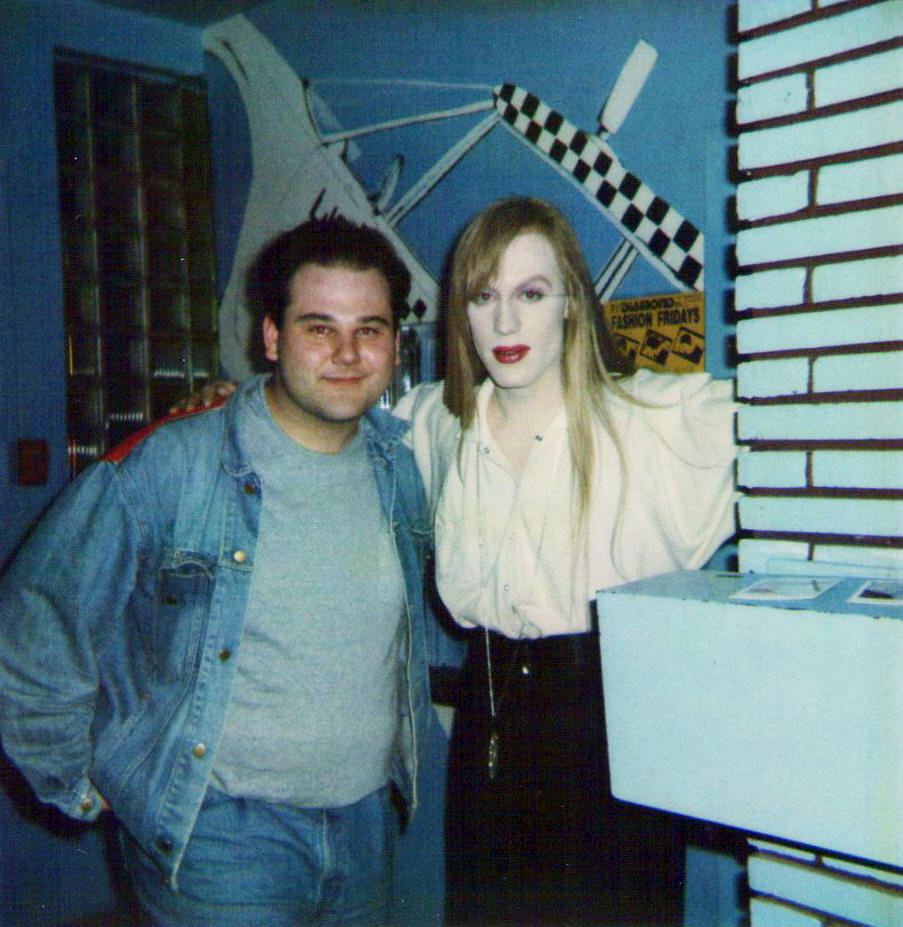
Diamond regular Paul Crossen (left) with Kinga, performer and Diamond staffer. Photo courtesy of Crossen.
What happened to it: After spinning at The Diamond for most of its seven years—he broke from the fold to DJ at The Copa for a stretch—Jason Steele lost his residency late in 1990. Audience numbers dropped sharply.
“Draw your own conclusions, but when I left, the place was at capacity on the weekends and very shortly thereafter the doors were closed forever,” says Steele, who went on to DJ at Klub Max, become a Toronto rave pioneer, and release records as Deko! on Plus 8 sister label Probe.
Randy Charlton offers another set of circumstances.
“The building had been sold the previous year and there was a fair bit of acrimony between the new owners, who were a couple of lawyers, and Pat Kenny. The lease was up, there were negotiations… and, well, the money that they wanted was too much in Pat’s mind. He also felt that bigger clubs tend to have a finite lifespan as a certain name. The lease expired December 27, 1990, and I was able to convince the two lawyers to let us get through New Year’s Eve. I tried to see if I could work something out with them to keep going but, by Jan. 16, Pat had pulled out and the owners basically shut us down.”
The Diamond closed and Charlton went on to work at venues including Albert’s Hall, Club 279 at the Hard Rock Café, and Jeff Healey’s Roadhouse. Charlton is now a talent buyer and assistant general manager at Sound Academy.
“I can safely say there has never been another club like The Diamond, as far as notoriety and fame for valid purposes,” summarizes Steele. “It was the hottest and most acclaimed live music and dance club venue. I’m not entirely sure any of us knew how much we’d miss it after the fact, and still do decades later.”
For the past decade, Steele has owned and operated PartyBusCanada.com, and continues to produce music.
Pat Kenny passed away in 2002, at the age of 73.
Eleven months after The Diamond closed at 410 Sherbourne, The Phoenix Concert Theatre rose in its place. The building was not greatly changed, although the westerly wall where The Diamond’s main stage once stood became The Phoenix’ long main bar. The Phoenix’ north-side stage was an elevated bar area at The Diamond.
The Phoenix has now operated successfully for more than 20 years. A documentary about its history, titled Strange Parody, Rise of a Generation, is currently in the works.
Thank you to Randy Charlton, Andrée Emond, Rawle James, Irena Joannides, Marva Jackson Lord, Jason Steele, Chris Torella, and Gary Topp for participating, as well as to David Barnard, Paul Crossen, Gokche Erkan, Stuart Berman, and Valdine Zakzanis.

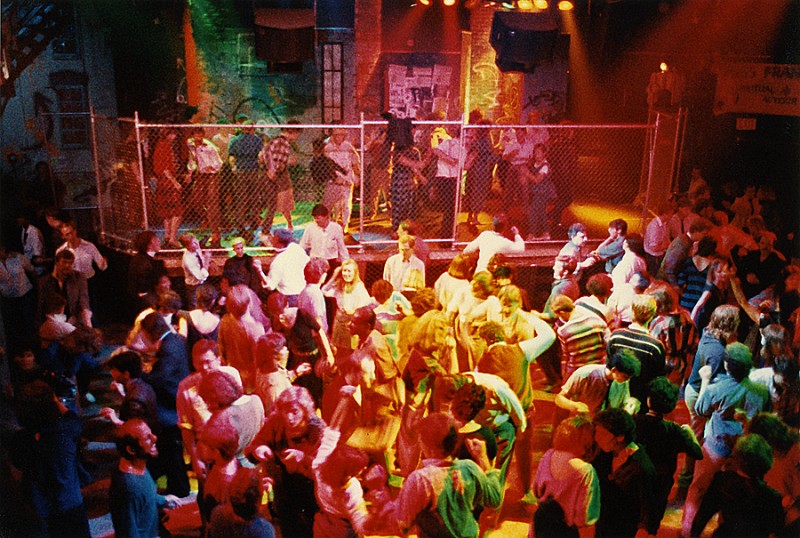
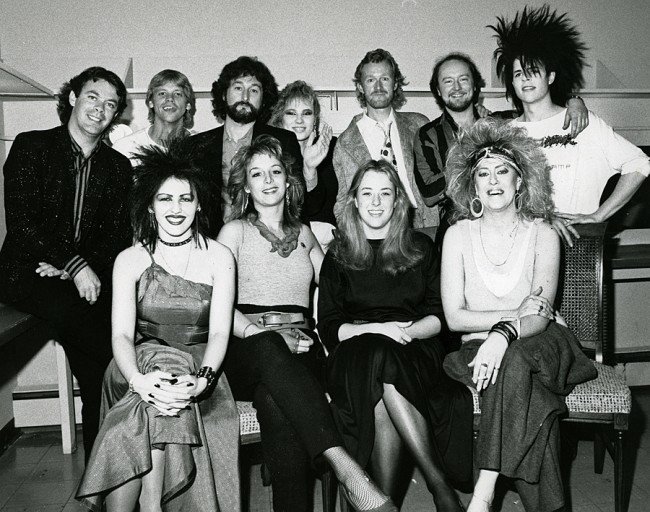
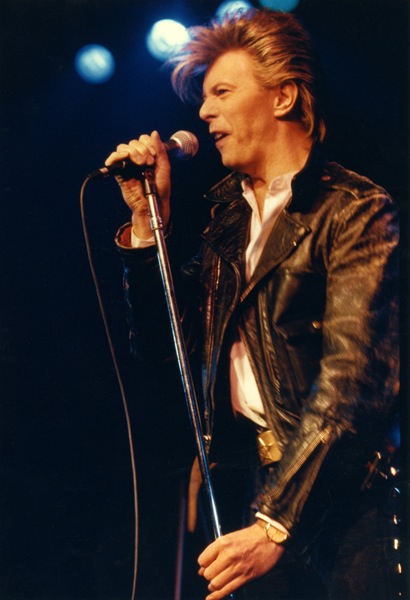
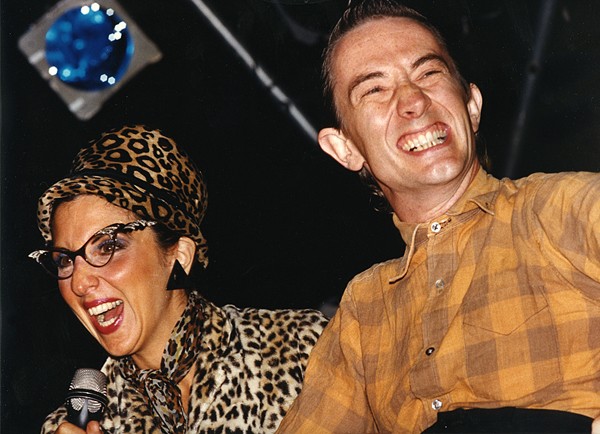

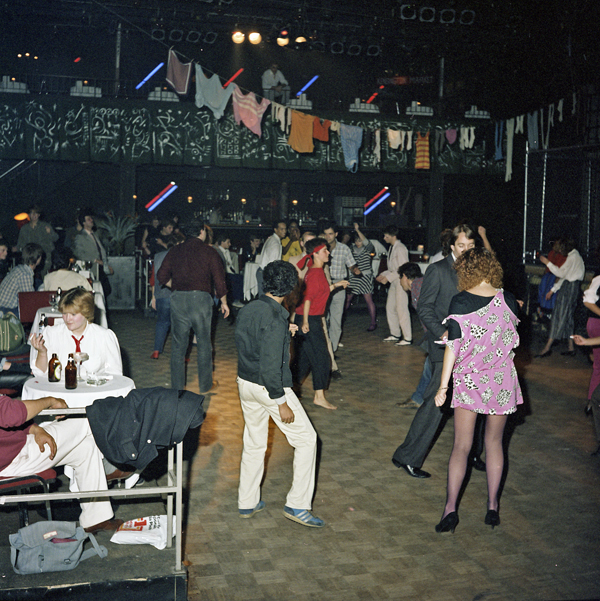
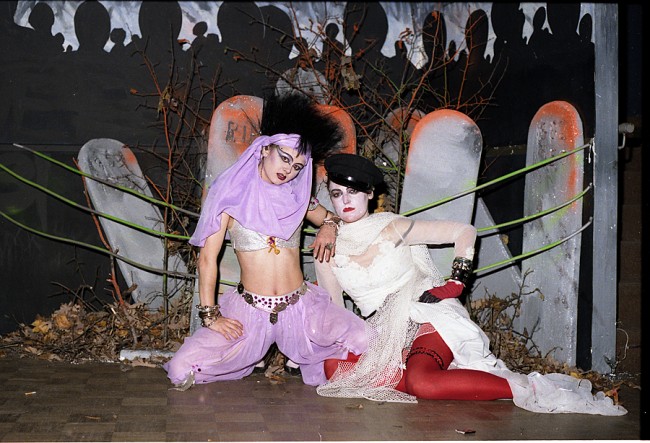
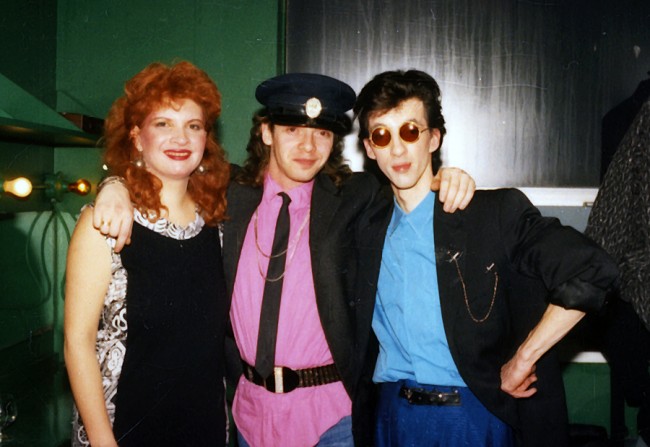
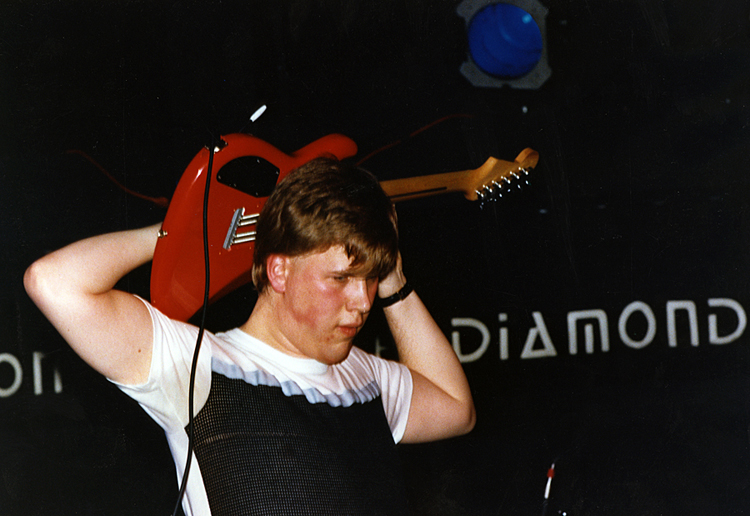
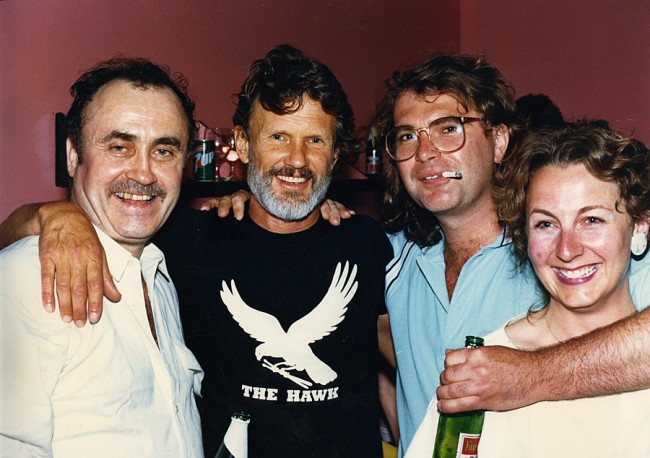
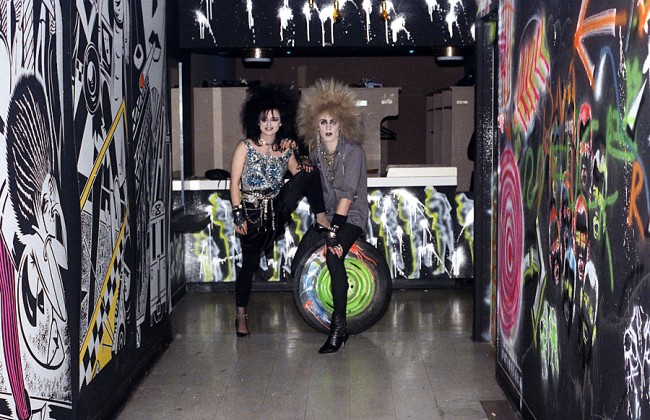
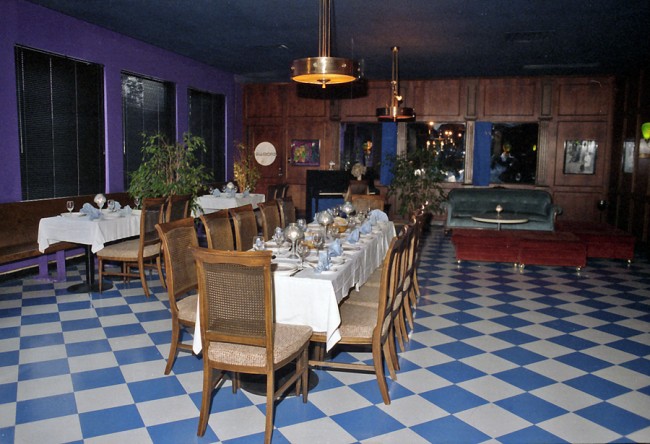
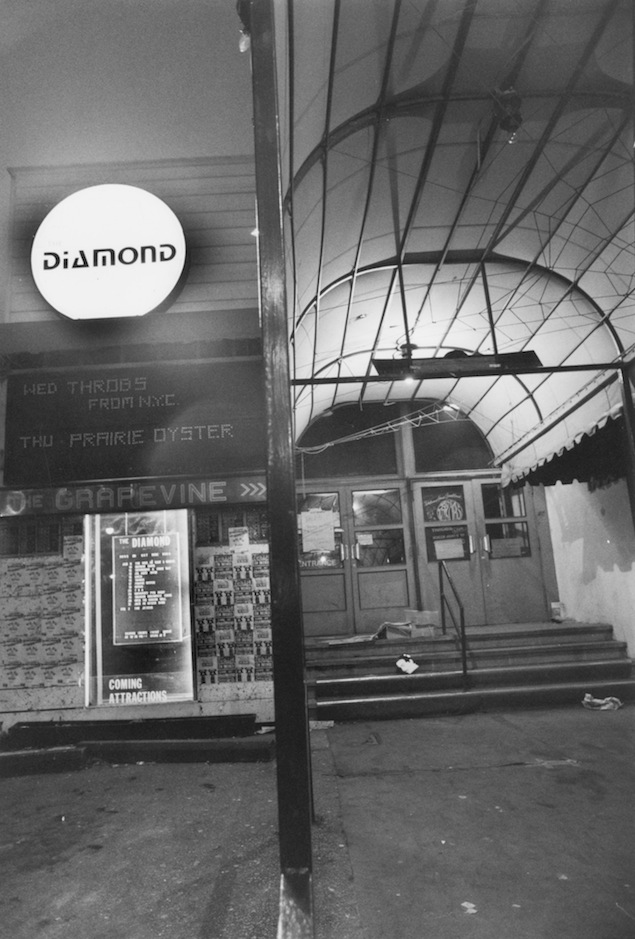
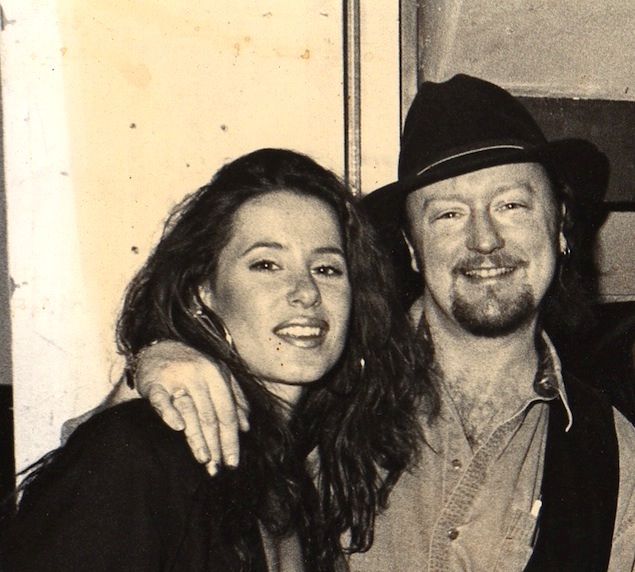
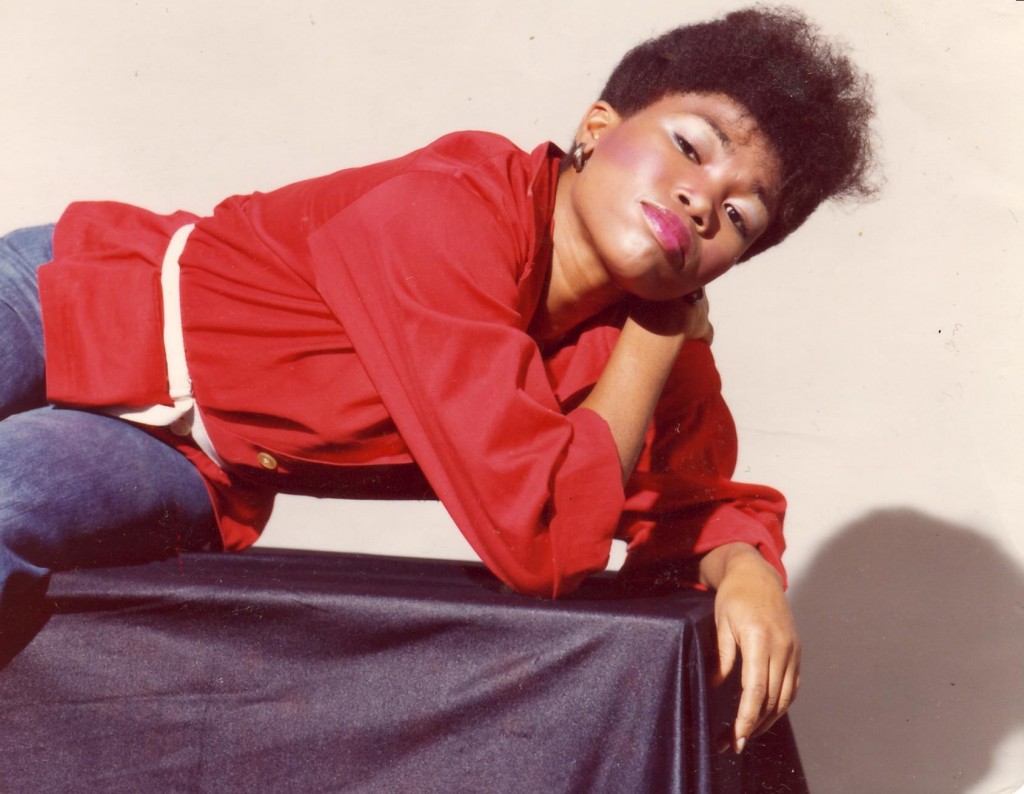
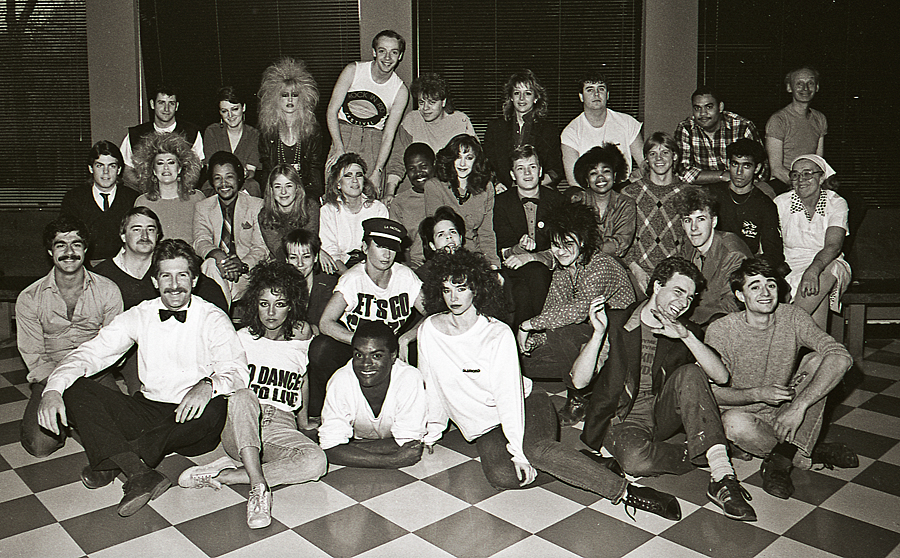
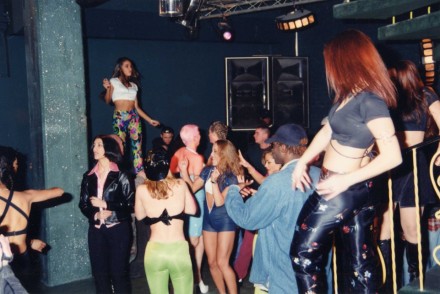
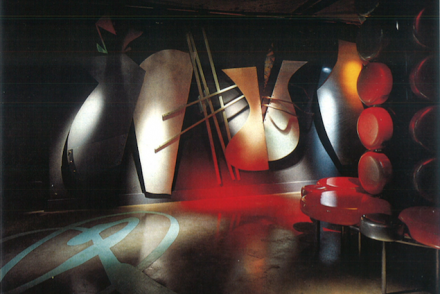
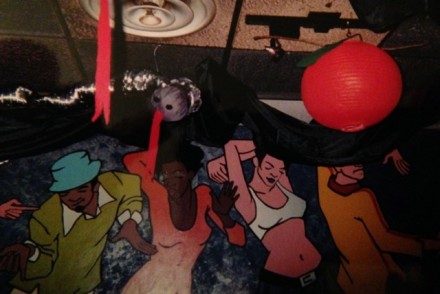

19 Comments
Hi guys,
anyone has stories, photos, videos of Gino Vannelli playing the Diamond?
Thanks folks
Cathrine Ohara, you would hear her laugh before you saw her. You hear that cackle as she was walking towards the front door.. Always fun, always a good hang. She would always stop and shoot the breeze for a few minutes with the door staff. Then there was a certain Swedish Maple Leaf who I used to have to chase outta the women’s bathroom. He would park himself in there, sit on the counter, chat up all the ladies and spoon out some of his stash. It was all such a cliche. He would spend like a lot of time in there. Sooner or later, a woman would come and tell me, “hey Bruce, that guy is in the woman’s washroom again”. I’d actually have to go in and tell him to cut it out. He’d laugh, and tell me “ok, ok…I won’t do that any more”.He’d be back in there a half hour later…hey nobody really complained. He was a generous man. We all found it pretty comical and bizzarre. My most memorable moment was when I actually got to sit and speak with the great Elvin Jones. after his show. It was after hours, very quiet, no distractions. We had a drink and talked for a while. Many many people passed thru the Diamond Club doors. Some that you recognise, some who you ain’t never heard of. All part of the whole thing. There was always the vibe of something happening, a strident energy. Yeah, it was a scene, and the music to make your head spin. Even on those long slow winter nights hangin around the front door tellin jokes with Lorelei. Sharin time and space with the people who worked there, The Diamond Dogs, is maybe the best memory of all. There is a big soft spot in my heart for that club. Thanks Randy C for just being you. Jim Zeppa and Jack Ross introduced me to my wife the love of my life…almost 40 years ago. If I never worked at The Diamond Club that magic woulda never happened.
I worked the door 1987 to 91. Do you know what happened to the people who worked there? Kings, Mickey, Sharon etc etc?
I worked the door with Jim Zeppa for the 1st year and a half of operation. Fond memories of Kinga and Gidget…Hobie. Lorelei my little sister. The staff was all of like mind. All a very tight knit group. It was a great moment in time. Not to be forgotten.
Paul – Mr. Dressup was the absolute best! So many memories with me and my group just dancing around him as he did his odd goose step kind of dance and those twirls. Crazy part – he shows up washing windows on Yonge street near the Summerhill LCBO. I was in my store and saw him and came out and said “aren’t you the guy who dances at the Diamond?” That’s how I officially met Paul, after having danced with him for months! Would love to know his story. Thanks for the memories, came here cause Kinga’s name popped into my head and wanted to see what happened to everyone!
Hello great reading & memories.
Do you have more on Mrs.night?
Thanks sam
Mr. Dressup? Is that the older guy that used to wear a blue Superman t-shirt in the late 80s? He always appeared to be on his own with the crazy hip swinging thing he did. He was a regular at RPM as well.
My gf and her friends used to call him “Mr Hips”.
There was also an odd 35yr old looking guy that would wear a sport coat round lensed glasses and a black turtle neck. He would walk quickly around the floor and on the stage and then do a 360 twirl, all with his hands in his pockets.
Damn — the memories of some of these characters from the 80s Toronto Club scene.
Totally remember the second guy – his name was Paul and actually saw him when he was working during the day. His day job was cleaning windows on storefronts on Yonge street (up near Summerhill area).
He definitely had an odd dancing style but boy, was he a regular fixture at the Copa on Sunday nights and the Diamond on Tuesdays – and probably the BigBop too.
[…] by spinning at Toronto venues including Zambukie on College, The Catwalk on Richmond, and The Diamond Club on […]
Off stage, “Kinga, Gidget and, later, Dawna at the door and coat check were the faces of the club and set the pace with their extremely ambiguous cross of punk and glam,” offers Steele
“The crowd was diverse—something unheard of in a mainstream venue at the time —bringing together people of various ethnicity and sexual orientations. This was the big strength of the night, and its impact on so many levels”
These two references sum up the Diamond in the 80′s. You knew the moment you walked thru the front door and were greeted by the doorcheck gang, you were in for a different kind of nightlife experience, compared to The Copa, Spectrum or RPM. I think that since it was just so accepting and progressive in its time, it also felt completely safe.
anyone remember who opened for Jaynes Addiction when they played the diamond
I was at that show…cannot remember the opener
National Velvet
National Velvet
I was at that David Bowie afternoon show At The Diamond Club in 1987 at the height of his Glass Spider Tour. I remember it was a big deal with all the cameras and they made a video that went nationwide. Great memory for sure. Rockon!
I was at that Fishbone show.
Outstanding!
Saw at various times John Cale & Chris Spedding, Strawbs, Bruce Cockburn LAWG Benefit Concert, Blue Rodeo, John Lee Hooker with Jeff Healey opening at the Diamond. Also attended the album release party for Don Ross in the Grapevine. Actually fell asleep during a Cowboys Junkies show – too many late nights and in to work at 8:30AM.
For me at least, not quite as influential as the domino, and I saw more bands up at the Masonic Temple than you could shake a stick at. Still, some great bands I saw at the diamond included The Happy Monday’s, Shriekback, even Gerry and the Pacemakers.
All comments in the string below have been republished from their original appearance on The Grid website. We’re including the readers’ comments as they add to these Then & Now stories. We look forward to reading new comments here as well.
Pommao
Every weekend we would travel from the depths of Scarborough to experience The Diamond. From the second you got to the front of the line to hand in your cover you knew you weren’t in Kansas anymore. Jason Steele was legendary and introduced me and most of Toronto’s early club goers to what today is known as EDM, looking back I really felt like I was in on the ground floor of something truly groundbreaking. I loved the images projected on the screen hanging beside the DJ booth. I recall one night they ended up putting on the NHL playoff game in 87 which was the longest in history and finished at 2am…think that it was after last call so many stayed to watch the end of the game! So many awesome concert memories too…too many to mention. Thanks to all that made it so special. 5:20 am on May 8, 2014
sam(alyssa)
wow,what a great article Denise.IT took me down memory lane i was a barback there from 87-89 and lucky enough to share in the memory. 5:57 pm on December 4, 2012
JJ
Great article Denise! Does anyone know the song that Deko is playing in the video? Thanks! 3:43 pm on September 11, 2012
Michael
Well you forget the most inportant person who was involved with that club 12:29 am on September 12, 2012
Denise Benson
Thanks JJ. Happy you liked it. As for that track, I’m wondering the same. It’s been stuck in my head ever since Jason sent me the video clip! 9:40 am on September 12, 2012
Andrew Ross
it’s “Astoria” by 2 Body’s. 7:46 am on September 17, 2012